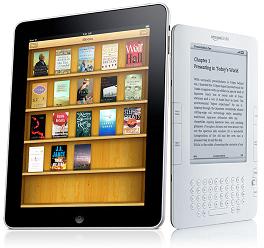
New e-readers like the Kindle or the iBook app on the iPad may put an entire library in your hands, but they may also be slowing you down. Usability guru Jakob Nielsen recently published his study on the reading speeds for those using printed books, the Kindle, and the iPad. His results propose that users slow down when reading on electronic media – 6.2% slower for iBooks, 10.7% slower for Kindle. While that could be disconcerting for you hardcore literary enthusiasts out there, Nielsen suggests that these results are actually quite promising for the new technology. Even 10% slower is still pretty good. While they’ve yet to outshine print, new e-readers are getting better and seem destined to one day replace ink on paper.
Examine the comments section for any review on iBook and the iPad and you’re bound to find at least one person who laments the sore-eyes and mild headaches that many associate with reading on a computer screen. Devices like the Kindle use e-ink in part to avoid these complaints, but have their own contrast problems to contend with. Users from Nielsen’s study confirmed these attitudes – with most saying they felt more comfortable and relaxed with the printed page. But their reading speeds tell a slightly modified story. A 10% delay is significant but not insurmountable. As screen resolutions improve and contrast levels are better controlled, and as the user interface is refined, we may find that such a delay can be overcome with time.
If the delay does, in fact, exist. I’m not sure how much I trust usability testing. These studies have very small sample sets (this one relied on just 24 users for its data) and rarely account for changes over time. While such small test groups make good sense when trying to find errors in a system, I’m not sure I trust them for measuring something as statistically variable as reading speed. In fact, due to the small sample size Nielsen reports that the difference between iPad and Kindle (6.2% vs. 10.7%) wasn’t significant though the delay versus print media was.
Of course, I don’t think I can dismiss the study. Far from it. Nielsen, part of the Nielsen Norman Group, is one of the more prominent experts on usability. If anyone was going to make a usability study on e-books that I should believe in it would probably be him. I trust his work even if I have my doubts about it’s overall….well, usefulness. If you’re like me, and have your doubts about the scientific veracity of these studies, I suggest you go read the iPad/Kindle report on UseIt.com. Nielsen’s pretty good about describing his methodology.
Maybe the study takes on a better meaning when we include how each reader rated their experience. iPad come out ahead at 5.8, followed by Kindle at 5.7, and print at 5.6 (reading on a PC garnered a meager 3.6). Even if they read a little slower, users seemed to enjoy the experience. That’s good news I think. e-Readers represent such a vast improvement in terms of economic, environmental, and spatial considerations that we probably will use them semi-exclusively in the years ahead. It’s comforting to know that we’re likely to still enjoy reading when we do.
[image credit: iPhoneAppFreelancer]
[source: UseIt/Nielsen Norman Group]



